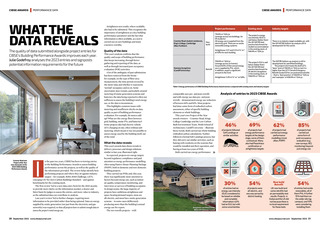




CIBSE AWARDS | PERFORMANCE DATA WHAT THE DATA REVEALS The quality of data submitted alongside project entries for CIBSEs Building Performance Awards improves each year. Julie Godefroy analyses the 2023 entries and signposts potential information requirements for the future Airtightness test results, where available, also had to be submitted. This recognises the importance of airtightness as a key building performance parameter and the fact that information is often available, as a test is carried out on new buildings and many extensive retrofits. Quality of the data This years analysis confirms that the quality and scope of building performance data keeps increasing, through better gathering and reporting of the data, as well as through increased post-occupancy evaluation (POE) activities. A lot of the ambiguity of past submissions has been removed from the forms for example, on the type of floor area measurement, the time period covered by the meter data and whether it represents normal occupancy and so on. Some uncertainty does remain, particularly around metering of onsite generation systems and batteries: the data being reported is often not sufficient to assess the buildings total energy use, or the data is inconsistent. This highlights common issues with metering and insufficient checks on data quality as part of building performance evaluation. For example, do meters add up? What are the energy flows between grid, building, onsite PVs, and batteries? Some projects also had electric vehicle (EV) charging on site, often without submetering, which meant it was not possible to assess energy used by the building itself, out of the total. What the data reveals ACranmer Road won Project of the Year (non-domestic) at the 2023 CIBSE Building Performance Awards I n the past two years, CIBSE has been reviewing entries to the Building Performance Awards to assess building performance across the projects, as well as the quality of the information provided. The review helps identify bestperforming projects and where they sit against industry targets for example, RIBA 2030 Challenge, LETI, emerging UK Net Zero Carbon Buildings Standard and against benchmarks for the existing stock. The first review1 led to a new data entry form for the 2022 awards, to provide more clarity on the information needed, a clearer and fairer basis for judges to assess the entries, and more value to industry, as the submitted data can contribute to analysis. Last years review2 led to further changes, requiring more information to be provided rather than being optional. Data on energy supplied by onsite generation (not just from the electricity and gas networks) was required, so that all projects have to submit enough data to assess the projects total energy use. 20 September 2023 www.cibsejournal.com This years awards data shows trends in delivery processes and design solutions similar to last year, illustrated right. As expected, projects set energy targets beyond regulatory compliance and paid attention to energy performance modelling, often using Passive House Planning Package (PHPP), both in domestic and non-domestic building projects. They carried out POEs and, this year, there was significantly more attention to factors beyond energy use, such as indoor air quality, temperature monitoring, and interviews or surveys of building occupants. In design teams, the large majority of projects have ambitious airtightness and space-heating demand targets, most are all-electric, and most have onsite generation systems in some cases deliberately producing more than the buildings annual energy use for export. The two retrofit projects with